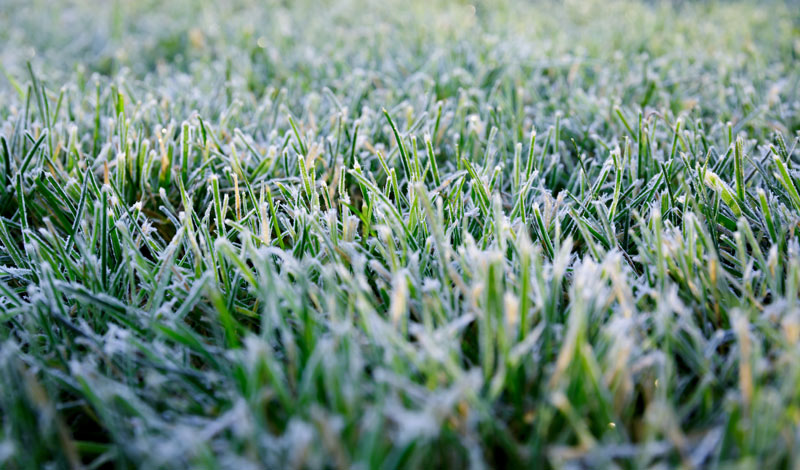
Frozen assets: Ice appearing as a light dusting of frost damages turf differently than ice that forms in other manners within the turfgrass system. Photo by Adobe Stock
I prefer warm weather, but I must admit that, when I was a teenager in the Kansas City area, I found ice issues during some winters to be interesting and enjoyable. Snowfall followed by freezing rain would create a surface that was ideal for riding a sled downhill through much of the neighborhood. Freezing rain once created over a half-inch of ice on road surfaces, and I remember seeing a neighbor ice-skating down our road. The same ice covering allowed for a 360-degree spin on a Flexible Flyer two-runner sled.
Of course, ice still appears in several forms during winter that can impact turf, be it ice inside the plant, ice covering the plant or ice on the leaf surface. The thick layers of skateable ice arising from freezing rain don’t seem to occur to the extent they did years ago; climate change is likely contributing.
Ice inside the plant
Ice routinely forms inside plants when temperatures drop below freezing. Where the ice forms is important — when it’s outside the plant cells, it’s usually not an issue. This is called extracellular freezing, and some grasses are more susceptible. The most important part of the turfgrass plant regarding survival is the crown, or growing point. Extracellular ice forces water inside cells to exit toward the ice (a matter of physics), and too much water leaving the cells will cause dehydration, which can cause the crown to die. This appears as winterkill in spring.
Editor’s note: Water is essential to growing high-quality turf, but how, exactly, does water “work” within turf? Find out in Water in turfgrass: Functions, flow and forms.
Ice formation inside cells of the crown, called intracellular freezing or crown hydration injury, commonly causes the death of grasses in the northern U.S. Usually, grasses that succumb to this type of injury become well hydrated in early spring, often growing in low areas that don’t drain well. Hydrated crowns that are then subjected to extremely low temperatures often suffer from ice formation inside cells of the crown. When this occurs, they don’t survive. This is common in the northern U.S. on annual bluegrass on putting greens, particularly turf growing in low spots where water may accumulate. The same is true for warm-season grasses in other parts of the country growing in low spots where extreme cold may occur.
Ice covering the plant
Fortunately, here in the central U.S., we don’t deal with extended periods of ice cover on turf. Ice cover can result from sleet, freezing rain, or snow melting and refreezing. Turf managers in the northern U.S. begin to worry about ice cover when it remains in place for about 60 days. That’s usually the limit for annual bluegrass — being under ice cover longer than that can cause issues with lack of oxygen and/or accumulation of toxic gases under the ice. Creeping bentgrass is more tolerant of ice cover than annual bluegrass is.
Editor’s note: Is it crown hydration or anoxia? Would a permeable or impermeable cover be best? Match injury to defense and get more know-how on seeing turf through winter in Winter turf damage and turf covers: A guide.
Ice on the leaf surface ... frost!
In a humid environment, when the leaf surfaces cool to temperatures below freezing, ice will form as frost on the leaves. Leaves of cool-season grasses tolerate frost just fine. Leaves of warm-season grasses don’t like frost, and we often see the leaves die shortly after the first hard frost in fall (i.e., the turf appears dormant). It’s important to remember that the crowns, rhizomes and stolons are still alive after frost affects warm- and cool-season grasses.
Frost is primarily a problem for turf managers in spring and fall on cool-season grasses when foot or cart traffic occurs. Foot or vehicle traffic pushes the ice crystals through the leaf surface and punctures cells, causing them to collapse. The result is often brown turf where traffic was present. Honestly, I don’t think we know enough about the physics of ice that constitutes frost, and I suspect that frost differs a lot — some ice forming on leaves may be more damaging than other ice.
To read more about frost on turf, see Frost delays: 5 things every golfer should know from the USGA Green Section.
Personally, I’m hoping for a relatively warm winter. If we have a storm approach and freezing rain causes ice to accumulate on the road outside my house, I don’t expect to be ice skating or attempting a 360-degree spin on a sled. I’ll be taking small steps with slip-preventive shoes to make sure I don’t fall. Time changes everything.
Jack Fry is a professor of turfgrass science at Kansas State University, currently working at the school’s Research and Extension Center in Olathe, Kan. He is a 25-year member of GCSAA.